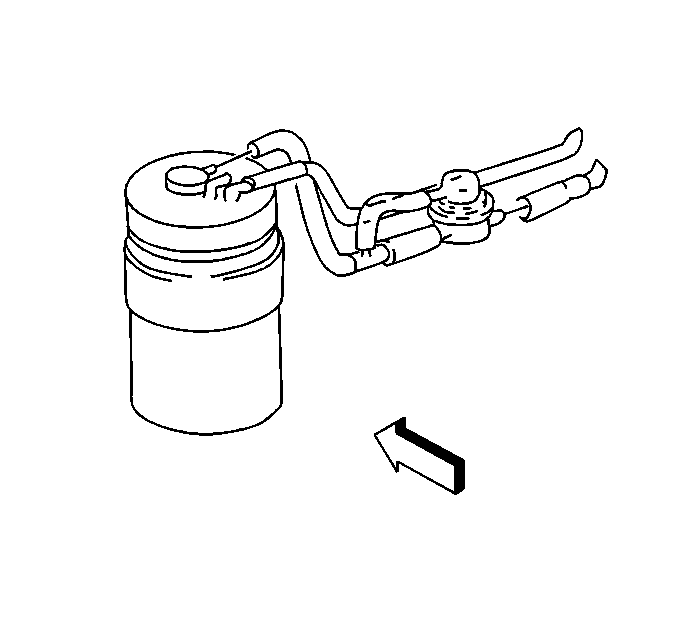Evaporative Emission Control System General Description
Purpose
The basic Evaporative Emission (EVAP) control system used on this vehicle uses the charcoal canister storage method. This method transfers fuel vapor from the fuel tank to an activated carbon (charcoal) storage device (canister) to hold the vapors when the vehicle is not operating. When the engine is running, the fuel vapor is purged from the carbon element by intake air flow and consumed in the normal combustion process.
EVAP Canister

Gasoline vapors from the fuel tank flow into the tube labeled tank. Any liquid fuel goes into a reservoir in the bottom of the EVAP canister to protect the integrity of the carbon bed above. These vapors are absorbed into the carbon. The canister is purged when the engine is running and commanded by Powertrain Control Module (PCM). Ambient air is allowed into the canister through the air tube in the top of the canister. The air mixes with the vapor and the mixture is drawn into the intake manifold.
Evaporative Emission System
The purge valve used with this canister uses pulse width modulation to control purge. This means that the PCM opens and closes the purge valve many times a second.
The PCM operates a Normally Closed (N/C) purge valve which controls the vacuum to purge the charcoal canister. Although the purge valve is connected to ported vacuum, the purge valve is commanded ON at idle. An idle purge passageway in the port allows purge at idle that can only be measured with a flow meter or inches of water vacuum gauge. With a cold engine, the purge valve is not energized by the PCM, which blocks vacuum to purge the EVAP canister.
The Evaporative Emission System also utilizes a purge vacuum switch located in the purge line between the canister and purge valve to detect when the system is purging fuel vapors from the canister and also to detect if the system is operating properly.
The PCM energizes the purge valve and allows purge when these conditions are met:
| • | The engine is warm. |
| • | After the engine has been running a specified time. |
The PCM feedback purge system is used on this application. The PCM uses inputs from the Oxygen Sensor (O2S) to regulate the purging of the canister. The PCM also has diagnostic capability to set a DTC P0441 or P1441 in the event the purge system malfunctions.
Results of Incorrect Operation
Poor idle, stalling and poor driveability can be caused by the following items:
| • | Inoperative EVAP canister purge valve. |
| • | Damaged EVAP canister. |
| • | Hoses split, cracked and, or not connected to the proper tubes. |
Evidence of fuel loss or fuel vapor odor can be caused by the following items:
| • | Liquid fuel leaking from fuel lines, or fuel pump. |
| • | Cracked or damaged EVAP canister. |
| • | Disconnected, mis-routed, kinked, deteriorated or damaged vapor hoses, or control hoses. |
If the EVAP canister purge valve is always open, the canister can purge to the intake manifold at all times. This can allow extra fuel during warm-up, which can cause a too rich operation.
If the EVAP canister purge valve is always closed, the canister can become over-loaded, resulting in fuel odor.
